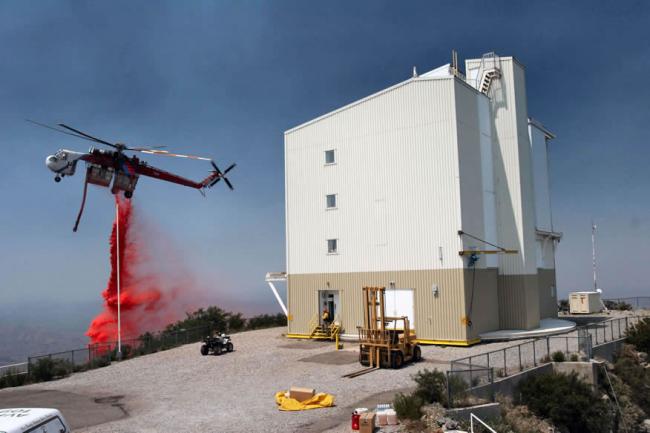
Cambridge, MA
Mother Nature has ended what she began 12 days ago. A forest fire sparked by lightning in the Santa Rita Mountains south of Tucson, Arizona, which spread to within a mile of the Fred L. Whipple Observatory, was effectively extinguished on Monday by more than an inch of rain. Areas of the fire will continue to smolder for some time, but the firefighting effort now will concentrate on keeping a watchful eye on the region.
"We are very grateful to the U.S. Forest Service and the firefighting team for their efforts throughout the fire," said Charles Alcock, director of the Harvard-Smithsonian Center for Astrophysics, which operates the observatory. "Their hard work protected the observatory until nature provided the final blow that doused the fire."
Fire crews devoted massive amounts of personnel and equipment to battling the blaze. Up to 1000 firefighters were assigned to the fire, many of whom focused on protecting the observatory by surrounding it with fire retardant and cutting fire lines. Their actions successfully held the fire in check until storms provided enough rain to extinguish it.
At the height of the blaze, firefighters prepared to conduct back-burning on the slopes of Mount Hopkins to deprive the oncoming fire of fuel. "Back-burning was our last resort because the back fires could have gotten out of control despite every safety precaution," said Steve Criswell, project manager for the observatory. "Fire crews prepared to do it three separate times when the fire moved closer, but every time the fire died back again. Fortunately, we didn't have to take that step."
Observatory personnel will be allowed to return to the summit of Mount Hopkins, the location of the telescopes, on Wednesday, July 20. They were evacuated on July12 when the fire approached to within a mile of the complex.
Approximately $100 million dollars worth of facilities and equipment located at the observatory were threatened by the blaze. The MMT Observatory alone, the largest and most valuable telescope on the mountain, hosts hundreds of researchers every year. The MMT is the flagship instrument of the Smithsonian Observatory, and is operated jointly by the Smithsonian and the University of Arizona. It was recently upgraded with a new 6.5-meter mirror and a suite of powerful instruments, including the Megacam imager and Hectospec and Hectochelle spectrographs. A number of other telescopes share the Mount Hopkins site with the MMT.
Headquartered in Cambridge, Mass., the Harvard-Smithsonian Center for Astrophysics (CfA) is a joint collaboration between the Smithsonian Astrophysical Observatory and the Harvard College Observatory. CfA scientists, organized into six research divisions, study the origin, evolution and ultimate fate of the universe.
David A. Aguilar
Director of Public Affairs
Harvard-Smithsonian Center for Astrophysics
617-495-7462
daguilar@cfa.harvard.edu
Christine PulliamPublic Affairs Specialist
Harvard-Smithsonian Center for Astrophysics
617-495-7463
cpulliam@cfa.harvard.edu